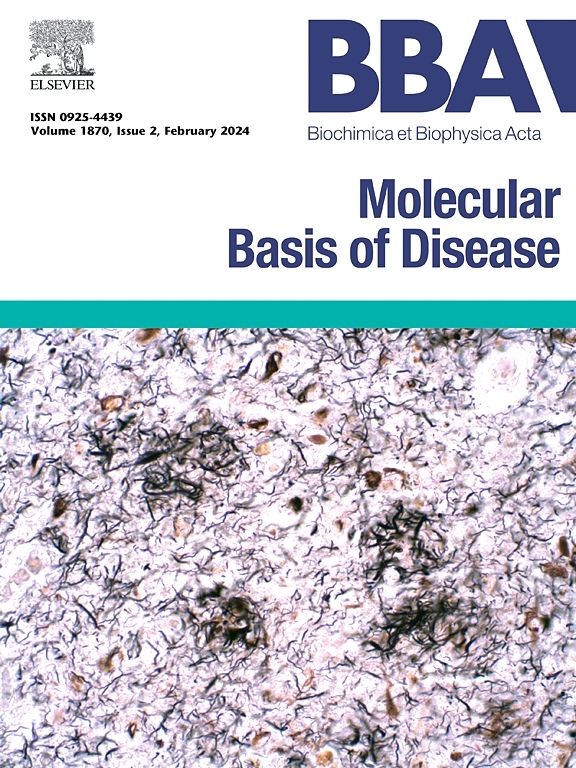光甘草定通过激活Nrf2/HO-1通路改善失血性休克所致急性肾损伤。
IF 4.2
2区 生物学
Q2 BIOCHEMISTRY & MOLECULAR BIOLOGY
Biochimica et biophysica acta. Molecular basis of disease
Pub Date : 2025-03-22
DOI:10.1016/j.bbadis.2025.167810
引用次数: 0
摘要
光甘草定是一种从甘草中提取的生物活性化合物,具有抗炎和抗氧化作用。在失血性休克(HS)引起的急性肾损伤(AKI)中很少有报道。本研究探讨光甘草定对hs所致肾损伤的影响及其可能机制。应用网络药理学方法对甘草治疗hs致急性肾损伤的有效成分靶点网络进行了分析。研究还考察了靶基因相关的生物学过程和信号通路。为探讨光甘草定对肾脏的影响,采用尾静脉注射光甘草定后,建立hs诱导大鼠股动脉出血模型。光甘草定改善了HS大鼠的肾功能,降低了血清中肌酐、尿素氮、中性粒细胞明胶酶相关脂钙蛋白水平和尿蛋白/肌酐比值。这与其对细胞凋亡和肾小管损伤的抑制作用是分不开的。此外,光甘草定对线粒体功能的保护作用表现在改善线粒体形态、减少活性氧、增加三磷酸腺苷和上调过氧化物酶体增殖体激活受体γ共激活因子1- α。这些作用有助于减少肾脏组织的炎症。体外研究缺氧/复氧诱导的HK-2细胞,在细胞模型中得到相同的结果。光甘草定在体内和体外均激活了Nrf2/HO-1信号通路,这可能是光甘草定保护肾组织的潜在机制。本研究揭示了光甘草定对HS大鼠肾脏的预防作用,为光甘草定作为小分子药物的开发提供了思路。本文章由计算机程序翻译,如有差异,请以英文原文为准。

Glabridin ameliorates hemorrhagic shock induced acute kidney injury by activating Nrf2/HO-1 pathway
Glabridin, a bioactive compound extracted from licorice, exhibits anti-inflammatory and antioxidative stress effects. It has rarely been reported in hemorrhagic shock (HS)-induced acute kidney injury (AKI). Here, the effects and potential mechanisms of Glabridin on HS-induced kidney injury was investigated. The active ingredient target network of licorice for HS-induced acute kidney injury was analyzed using network pharmacology. The study also examined the target gene-related biological processes and signaling pathways. To explore the impact of Glabridin on the kidney, a HS-induced rat model was established by femoral artery bleeding following tail vein injection of Glabridin. Glabridin improved kidney function evidenced by reduced levels of creatinine, urea nitrogen, neutrophil gelatinase-associated lipocalin in the serum, and the urinary protein/creatinine ratio in HS rats. This was inseparable from the inhibitory effect on apoptosis and kidney tubule injury. In addition, the protection of Glabridin on mitochondrial function was evident in the improvement of mitochondrial morphology, reduction of reactive oxygen species, increase in adenosine triphosphate, and upregulation of peroxisome proliferator-activated receptor γ coactivator 1-alph. These effects help reduce inflammation in kidney tissue. Hypoxia/reoxygenation-induced HK-2 cells were studied in vitro, and the same results were obtained in the cell model. Mechanically, Glabridin activated the Nrf2/HO-1 signaling pathway in vivo and in vitro, which may be a potential mechanism through which Glabridin protects kidney tissue. This study revealed the preventive effect of Glabridin on the kidney of HS rats, and provided insights for the development of Glabridin as a small molecule drug.
求助全文
通过发布文献求助,成功后即可免费获取论文全文。
去求助
来源期刊
CiteScore
12.30
自引率
0.00%
发文量
218
审稿时长
32 days
期刊介绍:
BBA Molecular Basis of Disease addresses the biochemistry and molecular genetics of disease processes and models of human disease. This journal covers aspects of aging, cancer, metabolic-, neurological-, and immunological-based disease. Manuscripts focused on using animal models to elucidate biochemical and mechanistic insight in each of these conditions, are particularly encouraged. Manuscripts should emphasize the underlying mechanisms of disease pathways and provide novel contributions to the understanding and/or treatment of these disorders. Highly descriptive and method development submissions may be declined without full review. The submission of uninvited reviews to BBA - Molecular Basis of Disease is strongly discouraged, and any such uninvited review should be accompanied by a coverletter outlining the compelling reasons why the review should be considered.

 求助内容:
求助内容: 应助结果提醒方式:
应助结果提醒方式:


